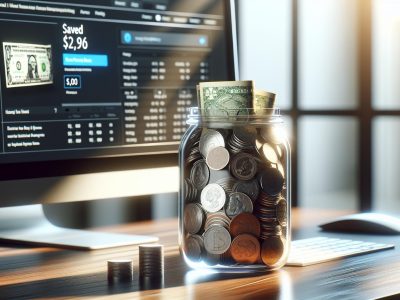Difference Between Check and Savings Account: Key Features, Benefits, and How to Choose
Picture yourself standing at the crossroads of your financial journey. On one side is the bustling avenue of checking accounts—money flowing in and out like city traffic, each transaction quick and purposeful. On the other, a quiet garden of savings accounts waits, promising growth and security beneath the surface, your funds quietly multiplying while you plan your next move. why banks offer both or how choosing one over the other could shape your financial future? The answer isn’t just about access or interest rates—it’s about unlocking possibilities you might not expect. Understanding the subtle differences between these accounts could reveal hidden perks, from unexpected rewards to smarter money management strategies. Get ready to discover how choosing the right account can transform the way you handle your hard-earned cash.
What Is a Checking Account?
Checking accounts act like the main stage for your daily financial moves. You swipe your debit card at grocery stores, withdraw cash from ATMs in New York or Los Angeles, and even pay bills online in seconds—all these actions pass through checking accounts (banks like Bank of America, Chase example). Because checking accounts link directly to your money, you’ll find it easy grab some cash when you need it and deposit paychecks from employers, like tech startups or retail chains, without a hitch.
Banks, credit unions, and fintech companies offer checking accounts, each with their own set of perks. For instance, Ally Bank boasts no monthly fees, while Wells Fargo gives extensive ATM networks—what’s most important to you? Maybe you want mobile alerts for every transaction, or you’re looking for overdraft protection in case you accidentally go over your balance. Some banks, like Chime and Capital One, promote early direct deposit, which means your paycheck arrives up to two days sooner than the traditional payday cycle.
Checking accounts rarely earn interest, except in some hybrid account offerings at online banks (American Express High Yield Checking, for example). This absence of growth aligns with their primary function: frequent, flexible access. While savings accounts reward patience with higher interest rates, checking accounts let you move your money quickly—something small business owners, gig economy workers, and parents juggling family expenses depend on every day.
What happens if you overdraft your account? You’ll usually get charged a fee, although a growing number of banks cap overdraft costs or eliminate them. When you write checks, use a debit card, or set up automatic payments, money flows right out. If you’ve ever wondered why your balance is suddenly lower than expected, it’s often due to recurring payments or pending transactions that haven’t cleared yet.
Why so many choose checking accounts as their go-to tool relies on their adaptability. Depositing birthday checks from relatives or splitting the dinner bill with friends—these actions highlight why checking accounts remain at the heart of personal banking ecosystems. Are there risks? Sure, if you don’t watch your balance closely or forget about monthly maintenance fees, you could lose unnecessary dollars. Still, when stay vigilant, checking accounts keep your financial journey humming.
What Is a Savings Account?
Picture your money as seeds, and a savings account as a sunny garden bed—it’s where your funds grows, bit by bit, safe from the traffic of daily spending. You put your extra cash in, and the bank waters it with interest. You might wonder, how is this helpful? Let’s break it down.
A savings account lets you deposit funds that isn’t for everyday use. Think about your big dreams: a trip to Yellowstone, a surprise birthday bash, or an emergency fund for life’s curveballs. Your savings can sit and slowly build thru monthly interest, usually calculated as an annual percentage yield (APY) by banks like Chase or online-first institutions such as Ally. According to the FDIC, the average savings APY in the US reached 0.45% in April 2024, though some online banks offer rates above 4.0%. That could meant your money quietly multiplies, earning with zero effort on your part.
Many people find comfort in the idea of separating spending money from money that want to grow. Out of sight, out of mind—until a rainy day comes. For example, Jane, a high school teacher, funneled a portion of each paycheck into her savings account. When her car broke down, she didn’t panic—her garden had bloomed just in time.
Most savings accounts, whether at Bank of America or credit unions, restrict how often you can withdrawal, traditionally up to six times per month, which can keeps you from dipping in too often. If you try to use it like a checking account, those withdrawal limits may trip you up, but they also help your goals stay on track.
How do you pick a savings account that works for you? Consider the APY, but peek at minimum balance requirements, monthly maintenance fees, and digital access tools, too. High-yield savings accounts offered by fintechs—think Marcus by Goldman Sachs—can boosts your earnings, but sometimes at the cost of physical branches or check-writing.
Do you want your savings front and center, or tucked away where they’ll flourish? Each banking institution offers unique features: some make transferring money from checking instant, others incentivize round-up savings every time you swipe your debit card. According to NerdWallet, digital-only banks can offer higher rates and better tools, but traditional banks might win with customer face time and ATM access.
Ask yourself: is your money just sitting idle, or is it working for you? By understanding the nuances of savings accounts—from APYs and access restrictions to the psychological power of setting money aside—you plant the seeds for growth, no matter if your harvest is six months or six years away.
Key Differences Between Checking and Savings Accounts
Checking and savings accounts deliver distinct experiences for your everyday finances. Looking past the surface, differences in function, features, and perks change how you interact with your money every day.
Main Purpose and Usage
A checking account, like a financial hub, manages daily transactions—think groceries at Kroger or paying your Netflix subscription. This account functions as your working wallet, with unlimited withdrawals and deposits. Savings accounts, by contrast, act more like a vault, designed to store money safely for future dreams or unexpected storms. People often use them for setting aside a vacation fund or building an emergency cushion. Consider: If cash liquidity is your top concern, a checking account’s for you. If you crave disciplined growth, savings accounts set boundaries that help you resist temptation, though you might feel a little restricted.
Access to Funds
Money in a checking account, accessible 24/7 through debit cards, checks, wire transfers, and ATMs, practically sits in your pocket. For example, Bank of America’s mobile apps put your entire account at your fingertips, while large ATM networks like Chase’s mean cash is hardly ever far away. Savings accounts, typically, restrict direct transactions—a federal regulation called Regulation D once capped withdrawals at 6 per month, even though that limit got lifted in 2020 (FDIC). Still, many banks maintain limits to encourage saving. So, moving money out of savings might take extra steps or, sometimes, even incur a fee.
Interest Rates and Earnings
Earnings on balances mark a clear divide between these two accounts. Checking accounts almost never pays interest; those that do, such as Ally’s Interest Checking, offer only around 0.25% APY, which trails behind inflation. Savings accounts, conversely, reward you for letting your money sit—a key APY to note: the national average hovers around 0.45% (FDIC, March 2024), while online banks like Marcus by Goldman Sachs advertise up to 4.4%. Consider the story of someone who shifted $5,000 from checking to a high-yield online savings account, netting $220 in interest over 12 months instead of a few pennies—compound interest really does the heavy lifting over time.
Fees and Minimum Balance Requirements
Fees and minimum requirements can surprise even careful savers. Many checking accounts charge overdraft or monthly maintenance fees—Chase, for instance, sets a $12 fee unless you direct deposit at least $500. Savings accounts may charge if you dip below the minimum balance or exceed withdrawal limits; Wells Fargo assesses a $5 monthly penalty if your account falls under $300. Credit unions and digital-only banks, like Chime, often remove these hurdles entirely. Ask yourself: Are your spending habits likely to trigger these charges? Comparing terms and reading the fine print can be as valuable as the money you deposit. Ambiguity lurks here for those unaware, so comb through each condition with a critical eye.
| Account Type | Main Use | Access to Funds | Typical APY (%) | Example Fees | Min. Balance Example |
|---|---|---|---|---|---|
| Checking | Daily spending, bills | Unlimited, immediate | 0.01–0.25 | Overdraft, monthly maintenance | $0–$1,500 |
| Savings | Future goals, reserves | Limited, less immediate | 0.45–4.40 | Excess withdrawal, low balance | $0–$300 |
Which Account Should You Choose?
Finding the right account often feels like choosing the door you’ll walk through each day or the vault you’ll keep locked for dreams tomorrow. People’s lives rarely follow one script: sometimes there’s a need for instant access, sometimes there’s a need for patience and growth.
Factors to Consider
Think about your daily routine first—maybe you swipe your debit card at the local coffee shop every morning, or perhaps you’re someone who likes to stash away a little from every paycheck, letting time and interest do the heavy lifting. Factor in frequency of transactions, access to cash, and the emotional relief that comes with seeing money grow. Checking accounts—offered by banks like Chase, Wells Fargo, or digital-first firms such as Chime—stand ready for constant movement and make sense for bill payments or frequent withdrawals. In contrast, savings accounts—such as Ally’s Online Savings or Capital One’s 360 Performance Savings—rewards discipline with higher APYs, separation, and security.
Can you picture opening your online banking app, and seeing your spendable cash low, but your emergency fund healthy? That’s the psychological firewall a savings account constructs. According to the FDIC, over 95% of US households held a checking or savings account in 2023, yet only 21% transferred fixed amounts regularly into savings (source: FDIC National Survey). Ask yourself: do you want instant liquidity, or the steady comfort of accumulation? Do fees chip away at your balance, or does each dollar sit untouched, gathering dust—or interest?
When to Use Both Accounts
Plenty folks—single parents with school-aged kids, freelancers juggling variable incomes, and new graduates learning financial independence—mix both accounts for reasons beyond mere access. Here’s a story: Trina, a freelance designer, keeps her rent and groceries flowing smoothly through her checking, while every design project’s bonus heads straight to her high-yield savings—her “travel dreams” jar. By splitting funds, she navigates between present demands and future ambitions, creating an invisible fence that curbs impulse spending.
Savvy savers set up automatic transfers. Suddenly, payday isn’t just money in, money out; it’s planting seeds in two fields. Checking handles bills, groceries, and those surprise dentist visits. Savings grows untouched except for big goals—like a home down payment or a safety net for layoffs. This two-account approach lets you leverage both liquidity and interest, freeing you from the tug of war between spending and saving.
Ever wonder why so many banks promote bundled accounts? Because combining checking and savings can maximize benefits—waived fees on one for balances in the other, or instant internal transfers to cover an accidental overdraft. If you manage both, you’re playing chess, not checkers, with your money.
What’s your next move: fast-flowing cash access, slow and steady growth, or the hybrid power of both doors open wide?
Conclusion
Choosing between a checking and savings account isn’t just about picking where to park your money—it’s about shaping your financial habits and supporting your goals. When you understand how each account works and the unique benefits they offer, you’re better equipped to manage your money with confidence.
Take the time to review your spending patterns and savings priorities. By making thoughtful decisions and using both accounts strategically, you’ll set yourself up for greater financial flexibility and long-term success.
- Understanding the Difference Between Yield and Return: Key Insights for Investors - October 1, 2025
- Key Differences Between Saving and Checking Accounts: Which Is Right for You? - October 1, 2025
- Top 7 Substitute Options for Bay Leaf to Enhance Your Recipes - October 1, 2025







